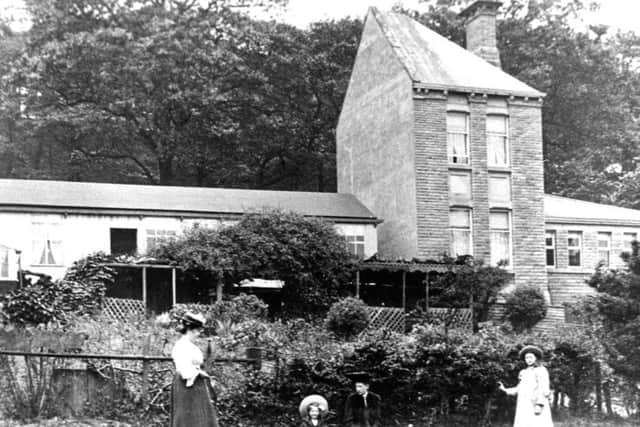The Nostalgia Column with Margaret Watson


One popular outing was to Coxley Valley, a picture of which is shown above, a special place for children and parents alike
Here is what Harold writes about those days:
“Playing games like Monopoly, Ludo, Tiddly Winks, Snakes and Ladders and jigsaw puzzles, were enjoyed by the whole family.


Advertisement
Hide AdAdvertisement
Hide Ad“There were also radio programmes which parents and children could watch together, and on cold winter evenings families often sat in front of the fire making prodded rugs by pushing strips of cloth through a hessian backing.
“Old clothes were cut up and used for this purpose.
“Other shared interests, included, reading, swimming and hobbies such as collecting stamps, wild flowers, buttons, badges and cigarette cards etc.
“Cigarette packets contained cards with pictures of sports teams and sports personalities, famous people and inventions.
“It was usually girls who played with dolls, doll’s houses and furniture, often making their own doll’s houses, furniture and fittings.
Advertisement
Hide AdAdvertisement
Hide Ad“Sewing and knitting skills were often passed down through the generations from grandma, and children often dressed up as adults or make belief characters.
“Meccano and Balsa Wood kits, were more stimulating and allowed children to build model structures and toys, such as Balsa wood aeroplanes.
“There was a good selection of quality metal toy soldiers cowboys and Indians, farmyard and zoo animals, but lead based paints were an obvious problem. Boys made trolleys or carts from old apple/orange boxes, scrap wood, pram wheels and lengths of clothes lines, connected to the carts to steer them.
“Girls and boys attended dancing classes, and also organised the occasional concert in order to raise funds for the war effort.
Advertisement
Hide AdAdvertisement
Hide Ad“Children played out day and evening (under the light of gas lamps), and would normally only go home for meals, bed or if the weather was bad.
“The Recreation Ground, known as the Rec, adjacent to Holroyd Park, was popular as it contained all of the major playground equipment, such as, swings, slides, seesaws, roundabouts and a covered shelter.
“Children also congregated in the streets. Watts’ sweet shop at the top of Bradbury Street became the headquarters of the Ravensthorpe Girl Guides.
The Ravensthorpe Prize Brass Band met and practiced in the room above, and the swimming baths in Dewsbury were always an attraction out of school hours.
Advertisement
Hide AdAdvertisement
Hide Ad“Children fortunate enough to own a pair of Roller Skates were obliged to skate on pavements or in school playgrounds.
“The skating rink on Bradford Road, Dewsbury, was destroyed by fire during the Second World War.
“Holroyd Park was a favourite location, summer and winter, where the boys were able to play cricket or football, depending upon the season.
“Children also played in the streets, with coats laid down for goal posts or dustbins used for wickets, and hopscotch was played with squares being chalked on the pavement – but chalking on pavements would never be allowed today.
Advertisement
Hide AdAdvertisement
Hide Ad“Skipping was mainly for girls, who were very good and often used two ropes rather than just one, skipping and singing at the same time.
“Hide and Seek. And Kick Can, a variation of hide and seek were played during the evenings under the street lights. Whip n’ Top was a game where children coloured their tops with chalk, making beautiful patterns as they spun round.
“Iron Hoop Rolling, where iron hoops were rolled, using a metal rod to propel them, and Peggy was played with a small piece of cigar shaped wood, pointed at both ends.
The Peggy was placed within a chalked circle and then hit on the pointed end with a stick to make it lift off the ground.
Advertisement
Hide AdAdvertisement
Hide Ad“The Peggy was then hit with the stick to make it travel as far as possible. A player had three attempts to hit the Peggy and any sort of a hit, even just a snick, meant the end of the turn. Opponents then took a turn each. Marbles were also very popular.
“Autumn was the time to play conkers which we usually found in Hopton Mills, although the mill management weren’t very happy when we threw sticks up into the trees to dislodge the conkers.
“October half term holiday was initially designed to allow schoolchildren to pick peas and potatoes in order to aid the war effort by helping the farmers. Payment was by the sack full, which took some filling.
“Very few children owned bicycles, but the ones who did were able to travel further afield, or take on a paper round.
Advertisement
Hide AdAdvertisement
Hide Ad“One beauty spot was, Coxley Valley, which was close to Horbury Bridge, a wooded area with a stream which ran through the valley.
A rope was attached to one of the trees to allow children to swing over the stream.
“Greenwood Locks was a popular destination in the school holidays, where we were allowed to operate the lock gates in order to let the barges through.
“Barges were horse drawn and when a barge reached a hump back bridge, the rope connecting the horse to the barge had to be disconnected.
Advertisement
Hide AdAdvertisement
Hide Ad“It was then lassoed, cowboy style, over the bridge and reconnected to the horse on the towpath at the other side of the bridge.
“There were two woods close to Ravensthorpe, Lady Wood and Hag Wood. Both were popular with local children, especially the Wolf Cubs and Boy Scouts, where the arts of woodcraft, tracking, fire lighting and basic camp fire cooking skills, were learnt. We also learnt about trees and bird life.
“Good money from tips could be earned by caddying for the golfers who played at the Dewsbury and District Golf Club.
To be continued.
If you have memories of childhood, contact me, [email protected].